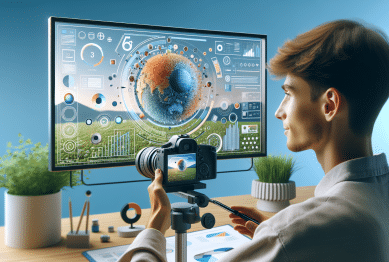Curiosity isn’t just about asking questions; it’s the driving force behind continuous learning. In a rapidly evolving world, staying curious can help individuals, teams, and organizations stay competitive. While technological advancements push the pace of change, curiosity is the key to adapting and growing. In this article, we’ll explore the role curiosity plays in learning, how to cultivate it, and why it’s essential for success in the modern workplace.

The Power of Curiosity in Continuous Learning
Curiosity, in essence, is an intrinsic desire to explore, understand, and learn. As a mental trait, it’s the spark that drives knowledge acquisition, innovation, and problem-solving. When curiosity is harnessed, it encourages people to ask the right questions, dig deeper into subjects, and embrace new skills and experiences.
At its core, curiosity propels continuous learning by making education feel like an exciting journey, not a mundane task. In the workplace, curiosity becomes even more crucial as it ensures individuals remain engaged and adaptable in an ever-changing landscape. Let’s dive into how curiosity leads to continuous learning and why organizations should cultivate it within their teams.
Why Curiosity Is Key to Lifelong Learning
Fostering an Adaptive Mindset
In a world of constant change, curiosity allows individuals to develop an adaptive mindset. It fuels the willingness to acquire new skills, enabling workers to evolve with new technologies and methodologies. A person who remains curious is more likely to embrace new challenges and find innovative solutions, fostering personal and professional growth.
Enabling Problem Solving and Innovation
Curiosity drives people to ask questions like, “What if?” or “How can this be improved?” Such inquiries lead to creative problem-solving and innovative solutions. Curiosity encourages individuals to think outside the box and explore alternatives, resulting in improved processes, products, and services. Organizations that prioritize curiosity often find themselves ahead of competitors in terms of innovation.
Expanding Knowledge and Skill Sets
One of the most practical benefits of curiosity is its role in knowledge expansion. Curiosity prompts individuals to seek out information, whether through self-guided research or formal education. This continuous acquisition of knowledge empowers people to expand their expertise and stay relevant in their fields. Whether learning a new language, mastering new software, or understanding emerging industry trends, curiosity keeps individuals and organizations ahead of the curve.
How to Cultivate Curiosity for Continuous Learning
While some may think curiosity is innate, it can be developed and nurtured over time. Below are practical ways to foster curiosity and incorporate it into your learning routine:
Set Learning Goals
Establish specific goals related to skills or knowledge you want to acquire. Whether it’s improving leadership abilities, learning coding, or understanding the latest marketing strategies, setting clear goals allows you to focus your curiosity in a targeted direction. It can also prevent feeling overwhelmed by endless areas to explore.
Engage with Different Perspectives
Engaging with diverse viewpoints and experiences can stimulate curiosity. Attend workshops, webinars, or conferences related to your field. Seek opinions from people in different industries, cultures, and backgrounds. Broadening your perspective helps you stay open-minded and receptive to new ideas.
Create a Habit of Reading
Reading is a simple yet powerful way to fuel curiosity. Set aside time daily or weekly to read books, articles, and blogs related to your professional and personal interests. It exposes you to fresh ideas and information, making continuous learning more enjoyable and accessible.
Ask More Questions
Curiosity thrives in environments where asking questions is encouraged. Whether at work or in personal life, ask more questions—both to others and yourself. Reflect on challenges you face and seek answers from different sources. By constantly questioning the world around you, you stimulate your brain’s curiosity and foster a growth-oriented mindset.
Embrace Failure as a Learning Opportunity
Fear of failure can stifle curiosity, but adopting a mindset where failure is viewed as a valuable learning experience can encourage continuous exploration. When you view mistakes as stepping stones, you’re more likely to stay curious and motivated to find new solutions.
Curiosity in the Workplace: Why It Matters More Than Ever
In the modern workplace, curiosity isn’t just a personal trait—it’s a strategic asset for organizations. Companies that nurture curiosity among their employees cultivate a culture of continuous learning, which translates into better problem-solving, creativity, and adaptability.
Here are a few reasons why curiosity is critical in the workplace:
Improves Employee Engagement
When employees are curious, they are more likely to stay engaged and proactive in their work. A curious mind leads to increased job satisfaction, reduced burnout, and higher productivity, as employees seek out new ways to improve their tasks and responsibilities.
Supports Innovation
Curiosity fuels innovation by prompting employees to experiment with new ideas, techniques, and technologies. This openness to trying new approaches leads to creative breakthroughs that can set a business apart in a competitive market.
Enhances Collaboration
A curious team is one that asks questions and seeks to understand diverse perspectives. This fosters collaboration and knowledge-sharing, leading to a more unified team that is capable of addressing complex challenges and driving success together.
Fosters Lifelong Learning and Adaptability
In a rapidly evolving job market, employees who maintain curiosity are more adaptable. Curiosity drives them to acquire new skills and stay current on industry developments, ensuring they remain valuable assets to their organization.
The Role of Technology in Enhancing Curiosity
Technology has greatly transformed how we explore new subjects and develop new skills. Thanks to platforms like Coursera, edX, and LinkedIn Learning, individuals can now access a wide range of educational materials. From coding and data science to leadership and entrepreneurship, these resources allow users to dive into a variety of topics at their own pace. Video tutorials, online courses, and virtual communities have made it easier than ever to expand knowledge and grow professionally.
Moreover, digital collaboration tools like Slack, Zoom, and Microsoft Teams make it easier for employees to connect and share knowledge with colleagues across the globe. These tools not only foster collaboration but also encourage a culture of curiosity where employees are more likely to engage in learning discussions and share new insights.
Conclusion
Curiosity is the cornerstone of continuous learning, both for individuals and organizations. It drives personal growth, sparks innovation, and promotes adaptability in an ever-changing world. By cultivating curiosity, setting learning goals, and leveraging technology, we can enhance our ability to acquire new knowledge, solve problems, and contribute meaningfully to our careers and organizations.
In the future, those who embrace curiosity will not only survive the challenges of a fast-evolving landscape but will thrive, continuously adapting and growing in response to new opportunities and challenges.
References:
- American Psychological Association (2023). “Curiosity and Its Impact on Learning.” Available at: https://www.apa.org
- Harvard Business Review (2023). “Why Curiosity Is Essential in the Workplace.” Available at: https://hbr.org
- Forbes (2023). “The Role of Curiosity in Innovation.” Available at: https://www.forbes.com









